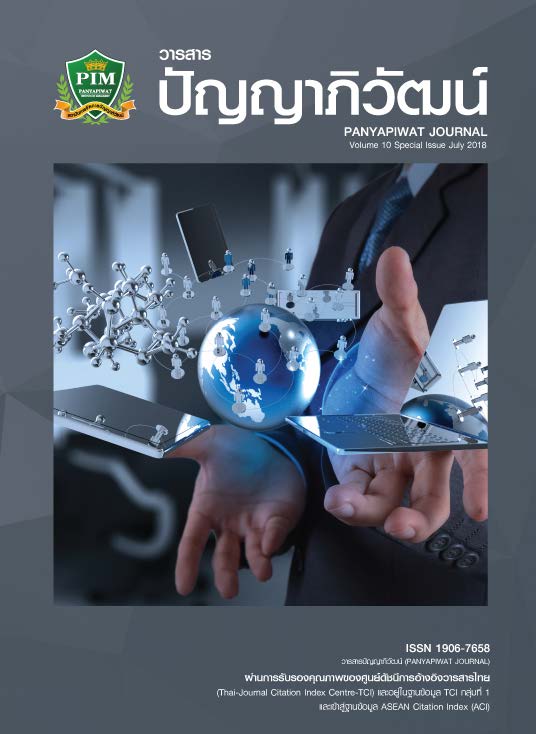CONTROLLING EMPLOYEE WEIGHT IN ORGANIZATION USING A NOVEL PROCESS OF MINDFULNESS-BASED CONSCIOUS AWARENESS (MB-CA)
Main Article Content
Abstract
The aim of this experimental research is to create a novel process known as “Mindfulness-Based Conscious Awareness” that can be used to manage employee body weight within an organization and prevent risks of Non-Communicable Diseases. This study selected 30 participants. The participants were put into two groups with ten being in the control group (not using the “Mindfulness-Based Conscious Awareness” Process) and the remaining 20 in the experimental group (using the “Mindfulness-Based Conscious Awareness” Process). The researcher monitored and measured the participants’ physiology and physical activity throughout the duration of the study. Results of the study showed that (1) During the use of the Process, the average physical activity of the control group maintained a normal level. The average physical activity of the experimental group increased notably and average sedentary time decreased continuously. (2) Monitoring the persistence of the effects after the Process ended, the physical activity of the control group maintained a normal level. The physical activity of the experimental group continued to increase despite the process being over and the average sedentary timecontinued to decrease. (3) (4) the pre- and post-experimental questionnaires and individual in-depth interviews of the experimental group showed that participants gained knowledge from the process to the point that it could be adapted to create health benefits.
Article Details
I and co-author(s) certify that articles of this proposal had not yet been published and is not in the process of publication in journals or other published sources. I and co-author accept the rules of the manuscript consideration. Both agree that the editors have the right to consider and make recommendations to the appropriate source. With this rights offering articles that have been published to Panyapiwat Institute of Management. If there is a claim of copyright infringement on the part of the text or graphics that appear in the article. I and co-author(s) agree on sole responsibility.
References
American College of Sport and Medicine. (2005). ACSM’s resource manual for guidelines for exercise testing and prescription (5th ed.). Lippincott Williams & Wilkins.
Arnin, J., Anopas, D., Triponyawasin, P., Yamsa-ard, T. & Wongsawat, Y. (2014). Development of a Novel Classification and Calculation Algorithm for Physical Activity Monitoring and Its Application. APSIPA 2014 Asia-Pacific, 1-4.
Barinaga, M. (2003). Buddhism and neuroscience: Studying the well-trained mind. Science, 302, 44-46.
Brown, J. & Isaacs, D. (2009). The World Café (translated by Thanasukthaworn, C. & SamaPutti, K.).Bangkok: Plan Printing. [in Thai]
Farb, N. A., Segal, Z. V., Mayberg, H., Bean, J., McKeon, D., Fatima, Z. & Anderson, A. K. (2007). Attending to the present: mindfulness meditation reveals distinct neural modes of self-reference. Soc Cogn Affect Neurosci,2(4),313-322.
Hu, M. B., Bai, P. D., Wu, Y. S., Zhang, L. M., Xu, H., Na, R., Jiang, H. W. &Ding, Q. (2015). Higher Body Mass Index Increases the risk for Biopsy-Mediated Detection of Prostate Cancer in Chinese Men. PLOS ONE, 10(4), e0124668.
Jha, A. P., Krompinger, J. & Baime, M. J. (2007). Mindfulness training modifies subsystems of attention. Cogn Affect Behav Neurosci, 7(2), 109-119.
Kearney, D. J., Milton, M. L., Malte, C. A., McDermott, K. A., Martinez, M. & Simpson, T. L. (2012). Participation in mindfulness-based stress reduction is not associated with reductions in emotional eating or uncontrolled eating. Nutrition Research, 32(6), 413-420.
Lazar, S. W., Kerr, C. E., Wasserman, R. H., Gray, J. R., Greve, D. N., Treadway, M. T., McGarvey, M., Quinn, B. T., Dusek, J. A., Benson, H., Rauch, S. L., Moore, C. I. & Fischl, B. (2005). Meditation experience is associated with increased cortical thickness. Neuroreport,16(17), 1893-1897.
Luders, E., Toqa, A. W., Lepore, N. & Gaser, C. (2009). The underlying anatomical correlates of long-term meditation: larger hippocampal and frontal volumes of grey matter. Neuroimage,45(3), 672-678.
Mason, A. E., Epel, E. S., Aschbacher, K., Lustig, R. H., Acree, M., Kristeller, J., Cohn, M., Dallman, M., Moran, P. J., Bacchetti, P., Laraia, B., Hecht, F. M. & Daubenmier, J. (2016). Reduced reward-driven eating accounts for the impact of a mindfulness-based diet and exercise intervention on weight loss: Data from the SHINE randomized controlled trial. Appetite, 100, 86-93.
McGill, H. C. Jr., Herderick, E. E., McMahan, C. A., Zieske, A. W., Malcolm, G. T., Tracy, R. E. & Strong, J. P. (2002). Atherosclerosis in youth. Minerva Pediatrica, 54(5), 437-447.
Nakawiro, D., Losathien, P. & Suttijit, S. (2013). Mindfulness-Base Psychotherapy. Faculty of Medicine, Chiang Mai University. [in Thai]
Pamotecho, P. (2012). Main Way (2nd ed.). Bangkok: Amarin Dharma Publishing. [in Thai]
Ritskes, R., Ritskes-Hoitinga, M., Stødkilde-Jørgensen, H., Bærentsen, K. & Hartman, T. (2003). MRI scanning during Zen meditation: the picture of enlightenment? Constructivism in the Human Sciences,8(1), 85-89.
Thammarangsi, T., Wongwattanakul, W. & Suriyawongpaisarn, W. (2014). NCDs Situation Report, Health Crisis, Social Crisis. Bangkok: Bureau of Health Policy Research and Disease Control Network Program International Health Policy Development Office. [in Thai]
World Health Organization. (2010). Global Recommendations on Physical Activity for Health. Geneva: WHO Press.
World Health Organization. (2015). Physical Activity and Adults. Retrieved July 10, 2016, from https://www.who.int/dietphysicalactivity/factsheet_adults/en/
World Health Organization. (2015). Physical Activity: Fact Sheet Nº385. Retrieved July 17, 2016, from https://www.who.int/mediacentre/factsheets/fs385/en/


